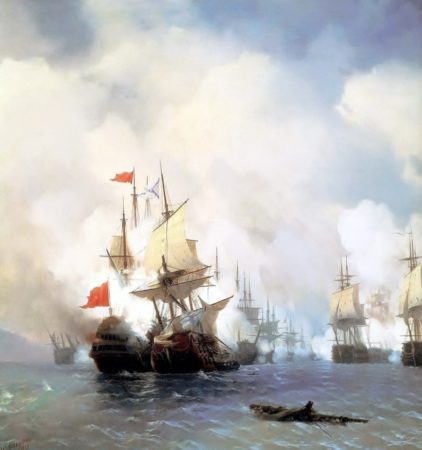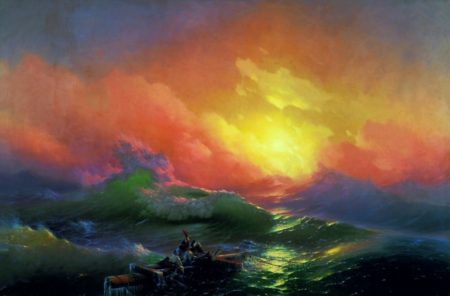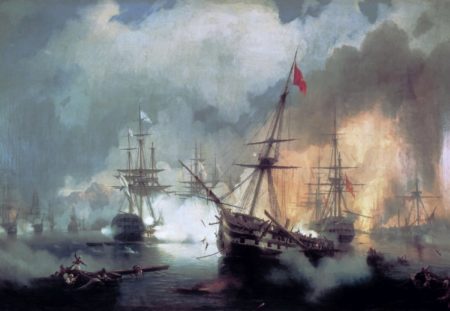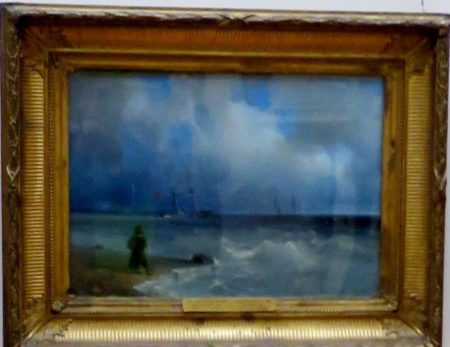By Catherine Tsounis
“You will see art work you will remember,” said our Moscow guide Irina Chetina during our visit of the Tretyakov Gallery. All I wanted to see was Byzantine civilization. But, in the process I learned about nationalities of the former Byzantine empire who forged remarkable careers in Tsarist Russia. The turbulent sea, persons fleeing in boats and religious themes concerning salvation are seen throughout medieval and modern Greek art.
A mesmerizing oil painting of sailors in rescue boats watching their ship sink in the turbulent sea grabbed my attention. “The Rainbow” is a mesmerizing painting showing Man’s struggle against, and love of nature in its entirety by Russian artist Ivan Aivazovsky. The name Aivazovsky had the root ai that is common for Orthodox Christians of the former Byzantine Empire. An oil painting of the “Bosphorus” reminded me of Constantinople (Istanbul). It had a mystical aura, in shadows. The “Seashore” painting reminded me viewing of Long Island turbulent waters crashing around the jetty of Mattituck, Long Island, New York.
I have seen Ivan Aivazovsky’s name under a painting called “The Battle of Navarino”, shown in Greek textbooks, newspapers and websites. I was amazed a Russian wrote about the decisive battle that Gave Greece its Independence. Scholars told me this Russian drew paintings showing Greek naval battles. Recently, I saw the “Battle of Navarino” in the 2017 Greek newspapers. “Battle of Navarino, by Ivan Aivazovsky, showing the Russian squadron, in line ahead (left-center, white flags with blue transversal crosses) bombarding the Ottoman fleet (right, with red flags). The Battle of Navarino was a naval battle fought on 20 October 1827, during the Greek War of Independence (1821–32), in Navarino Bay (modern-day Pylos), on the west coast of the Peloponnese peninsula, in the Ionian Sea. Allied forces from Britain, France and Russia decisively defeated Ottoman and Egyptian forces trying to suppress the Greek war of independence, thereby making much more likely the independence of Greece.1
The Tretyakov gallery visit, through the eyes of our guide Irina, opened my eyes to the fact that Greek Independence images were painted not just by a Russian painter. “He is considered one of the greatest marine artists in history. Baptized as Hovhannes Aivazian, Aivazovsky was born into an Armenian family in the Black Sea port of Feodosia in Crimea and was mostly based there.”2
He painted the “Battle of Chios”, also known as “The Battle of Chesma”, 1770. This battle has been handed to each generation as a moment for possible Greek freedom in Western Asia Minor.3 The naval Battle of Chesma took place on 5–7 July 1770 near and in ÇeÅŸme (Chesme or Chesma) Bay, in the area between the western tip of Anatolia and the island of Chios, which was the site of a number of past naval battles between the Ottoman Empire and the Republic of Venice. It was a part of the Orlov Revolt of 1769, a precursor to the later Greek War of Independence (1821–29), and the first of a number of disastrous fleet battles for the Ottomans against Russia.4
Ivan Aivazovsky’s childhood was spent in poverty on the outskirts of the city facing the beautiful Feodosia Bay and the ruins of an ancient Greek fortress. Young Ivan was mesmerized by the grandeur of the view and the heroic stories told about the Greeks and the famous battles of the past.5
Following his education at the Imperial Academy of Arts, Aivazovsky traveled to Europe and lived briefly in Italy in the early 1840s. He then returned to Russia and was appointed the main painter of the Russian Navy. Aivazovsky had close ties with the military and political elite of the Russian Empire and often attended military maneuvers. He was sponsored by the state and was well-regarded during his lifetime. The saying “worthy of Aivazovsky’s brush”, popularized by Anton Chekhov, was used in Russia for “describing something ineffably lovely.”[
One of the most prominent Russian artists of his time, Aivazovsky was also popular outside Russia. He held numerous solo exhibitions in Europe and the United States. During his almost 60-year career, he created around 6,000 paintings, making him one of the most prolific artists of his time.[6][7] The vast majority of his works are seascapes, but he often depicted battle scenes, Armenian themes, and portraiture. Most of Aivazovsky’s works are kept in Russian, Ukrainian and Armenia
He was a phil-Hellene artist who was awarded the Greek Order of the Redeemer in 1859. He was devoted to his homeland of Armenia and his home of birth Feodora, Crimea, of the Russian Empire. In the 1860s, the artist produced several paintings inspired by Greek nationalism and the Italian unification.[9][27] In 1868, he once again visited Constantinople and produced a series of works about the Greek resistance to the Turks, during the Great Cretan Revolution.[23] In 1868,
Aivazovsky died on 19 April (2 May in New Style) 1900 in Feodosia.[27] In accordance with his wishes, he was buried at the courtyard of St. Sargis Armenian Church.[41] A white marble sarcophagus was made by Italian sculptor L. Biogiolli in 1901.[42] A quote from Movses Khorenatsi‘s History of Armenia in Classical Armenian is engraved on his tombstone: Õ„Õ¡Õ°Õ¯Õ¡Õ¶Õ¡Ö Õ¸Ö‚ Õ®Õ¶Õ¥Õ¡Õ¬ Õ¡Õ¶Õ´Õ¡Õ° Õ¦Õ«Ö‚Ö€Õ¶ ÕµÕ«Õ·Õ¡Õ¿Õ¡Õ¯ Õ¥Õ©Õ¸Õ² (Mahkanatsu tsneal anmah ziurn yishatak yetogh),[43] which translates: “He was born a mortal, left an immortal legacy”or “Born as a mortal, left the immortal memory of himself”.6
Aivazovsky was not just a professional marine painter, he knew the sea and loved it. He developed a unique way of capturing its changing moods. Instead of copying directly from nature, he limited himself to pencil sketches. Coupled with his most important gift, an amazing visual memory, this enabled him to reproduce particular states of nature.7
One of his best-known works, The Ninth Wave, captures the struggle to survive against the force of the sea. The title refers to a common seaman’s expression meaning a single wave larger than the others. In the image, the wave threatens to engulf the tiny people clinging to their makeshift vessel. Aivazovsky’s use of light creates a glistening yet foreboding seascape. The viewer is at once hopeful that the people will be saved yet aware of their dire straits. Despite the tragic nature of the image the artist clearly admires the beauty of the sea. 8
My trip to Russia was a blessing. I met hard working persons like my European, immigrant Greek Orthodox relatives who believed in their Russian Orthodox religion and culture. I saw the truth because a member of my family, who is more liberal and open minded, that wanted to see “The Greeks of the North”. The Russian love of Greek culture and Orthodoxy that is woven in the History of Greece came alive to me. My deepest sympathy to the Russian community of St. Petersburg who lost school age children and adults in the deadly Metro bomb attack on April 3, 2017 morning.
References:
- https://en.wikipedia.org/wiki/
Battle_of_Navarino - https://en.wikipedia.org/wiki/
Ivan_Aivazovsky - https://
greekamericanexperience. wordpress.com/tag/chesma- church/. - https://en.wikipedia.org/wiki/
Battle_of_Chesma - http://russiapedia.rt.com/
prominent-russians/art/ivan- aivazovsky/ - https://en.wikipedia.org/wiki/
Ivan_Aivazovsky - https://en.wikipedia.org/wiki/
Ivan_Aivazovsky - https://www.guggenheim.org/
arts-curriculum/topic/coming- of-age-of-russian-art and https://uploads7.wikiart.org/ images/ivan-aivazovsky/the- ninth-wave-1850-1.jpg











